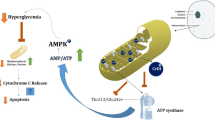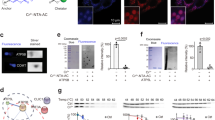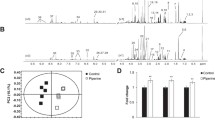Abstract
The micronutrient trivalent chromium, 3 + (Cr(III)), is postulated to play a role in carbohydrate, lipid, and protein metabolism. Although the mechanisms by which chromium mediates its actions are largely unknown, previous studies have suggested that pharmacological doses of chromium improve cardiometabolic symptoms by augmenting carbohydrate and lipid metabolism. Activation of AMP-activated protein kinase (AMPK) was among the many mechanisms proposed to explain the salutary actions of chromium on carbohydrate metabolism. However, the molecular pathways leading to the activation of AMPK by chromium remained elusive. In an elegant series of studies, Sun and coworkers recently demonstrated that chromium augments AMPK activation by binding to the beta-subunit of ATP synthase and inhibiting its enzymatic activity. This mini-review attempts to trace the evolving understanding of the molecular mechanisms of chromium leading to the hitherto novel pathway unraveled by Sun and coworkers and its potential implication to our understanding of the biological actions of chromium.


Similar content being viewed by others
Abbreviations
- AMP:
-
Adenosine mono phosphate
- AMPK:
-
AMP-Activated protein kinase
- ATP:
-
Adenosine triphosphate
- Cr3+-NTA-AC:
-
2,2′- (5- (2- (7-Azido-4-methyl-2-oxo-2H-chromen-3-yl) acetamido)-1-carboxylato-pentylazanediyl) diacetate
- IRS-1:
-
Insulin receptor substrate-1
- JNK:
-
C-jun-N-terminal kinase
- GLUT4:
-
Glucose transporter-4
- MALDI-TOF-MS:
-
Matrix assisted laser desorption ionization-time of flight mass spectrometry
- PDK1:
-
Phosphoinositide-dependent kinase
- PI3K:
-
Phosphoinositide 3-kinase
- PTP1B:
-
Protein-tyrosine phosphatase 1-B
References
Sreejayan N, Lin Y, Hassid A (2002) NO attenuates insulin signaling and motility in aortic smooth muscle cells via protein tyrosine phosphatase 1B-mediated mechanism. Arterioscler Thromb Vasc Biol 22:1086–1092
Yigzaw Y, Poppleton HM, Sreejayan N, Hassid A, Patel TB (2003) Protein-tyrosine phosphatase-1B (PTP1B) mediates the anti-migratory actions of Sprouty. J Biol Chem 278:284–288
Chang Y, Ceacareanu B, Dixit M, Sreejayan N, Hassid A (2002) Nitric oxide-induced motility in aortic smooth muscle cells: role of protein tyrosine phosphatase SHP-2 and GTP-binding protein Rho. Circ Res 91:390–397
Neel BG, Tonks NK (1997) Protein tyrosine phosphatases in signal transduction. Curr Opin Cell Biol 9:193–204
Denu JM, Dixon JE (1998) Protein tyrosine phosphatases: mechanisms of catalysis and regulation. Curr Opin Chem Biol 2:633–641
Meng TC, Fukada T, Tonks NK (2002) Reversible oxidation and inactivation of protein tyrosine phosphatases in vivo. Mol Cell 9:387–399
van Montfort RL, Congreve M, Tisi D, Carr R, Jhoti H (2003) Oxidation state of the active-site cysteine in protein tyrosine phosphatase 1B. Nature 423:773–777
Goldstein BJ (2001) Protein-tyrosine phosphatase 1B (PTP1B): a novel therapeutic target for type 2 diabetes mellitus, obesity and related states of insulin resistance. Curr Drug Targets Immune Endocr Metabol Disord 1:265–275
Panzhinskiy E, Ren J, Nair S (2013) Pharmacological inhibition of protein tyrosine phosphatase 1B: a promising strategy for the treatment of obesity and type 2 diabetes mellitus. Curr Med Chem 20:2609–2625
Gordon JA (1991) Use of vanadate as protein-phosphotyrosine phosphatase inhibitor. Methods Enzymol 201:477–482
Peters KG, Davis MG, Howard BW, Pokross M, Rastogi V, Diven C, Greis KD, Eby-Wilkens E, Maier M, Evdokimov A, Soper S, Genbauffe F (2003) Mechanism of insulin sensitization by BMOV (bis maltolato oxo vanadium); unliganded vanadium (VO4) as the active component. J Inorg Biochem 96:321–330
Davis CM, Vincent JB (1997) Chromium oligopeptide activates insulin receptor tyrosine kinase activity. Biochemistry 36:4382–4385
Wang H, Kruszewski A, Brautigan DL (2005) Cellular chromium enhances activation of insulin receptor kinase. Biochemistry 44:8167–8175
Chen G, Liu P, Pattar GR, Tackett L, Bhonagiri P, Strawbridge AB, Elmendorf JS (2006) Chromium activates glucose transporter 4 trafficking and enhances insulin-stimulated glucose transport in 3T3-L1 adipocytes via a cholesterol-dependent mechanism. Mol Endocrinol 20:857–870
Wang ZQ, Zhang XH, Russell JC, Hulver M, Cefalu WT (2006) Chromium picolinate enhances skeletal muscle cellular insulin signaling in vivo in obese, insulin-resistant JCR:LA-cp rats. J Nutr 136:415–420
Cefalu WT, Wang ZQ, Zhang XH, Baldor LC, Russell JC (2002) Oral chromium picolinate improves carbohydrate and lipid metabolism and enhances skeletal muscle Glut-4 translocation in obese, hyperinsulinemic (JCR-LA corpulent) rats. J Nutr 132:1107–1114
Vincent JB (1999) Mechanisms of chromium action: low-molecular-weight chromium-binding substance. J Am Coll Nutr 18:6–12
Stearns DM, Wise JP Sr, Patierno SR, Wetterhahn KE (1995) Chromium(III) picolinate produces chromosome damage in Chinese hamster ovary cells. FASEB J 9:1643–1648
Anderson RA, Bryden NA, Polansky MM (1997) Lack of toxicity of chromium chloride and chromium picolinate in rats. J Am Coll Nutr 16:273–279
Yang X, Palanichamy K, Ontko AC, Rao MN, Fang CX, Ren J, Sreejayan N (2005) A newly synthetic chromium complex-chromium (phenylalanine)3 improves insulin responsiveness and reduces whole body glucose tolerance. FEBS Lett 579:1458–1464
Yang X, Li SY, Dong F, Ren J, Sreejayan N (2006) Insulin-sensitizing and cholesterol-lowering effects of chromium (D-Phenylalanine)3. J Inorg Biochem 100:1187–1193
Dong F, Yang X, Sreejayan N, Ren J (2007) Chromium (D-phenylalanine)3 improves obesity-induced cardiac contractile defect in ob/ob mice. Obesity (Silver Spring) 15:2699–2711
Dong F, Kandadi MR, Ren J, Sreejayan N (2008) Chromium (D-phenylalanine)3 supplementation alters glucose disposal, insulin signaling, and glucose transporter-4 membrane translocation in insulin-resistant mice. J Nutr 138:1846–1851
Sreejayan N, Dong F, Kandadi MR, Yang X, Ren J (2008) Chromium alleviates glucose intolerance, insulin resistance, and hepatic ER stress in obese mice. Obesity (Silver Spring) 16:1331–1337
Dong F, Hua Y, Zhao P, Ren J, Du M, Sreejayan N (2009) Chromium supplement inhibits skeletal muscle atrophy in hindlimb-suspended mice. J Nutr Biochem 20:992–999
Sreejayan N, Marone PA, Lau FC, Yasmin T, Bagchi M, Bagchi D (2010) Safety and toxicological evaluation of a novel chromium(III) dinicocysteinate complex. Toxicol Mech Methods 20:321–333
Kandadi MR, Unnikrishnan MK, Warrier AK, Du M, Ren J, Sreejayan N (2011) Chromium (D-phenylalanine)3 alleviates high fat-induced insulin resistance and lipid abnormalities. J Inorg Biochem 105:58–62
Hua Y, Clark S, Ren J, Sreejayan N (2012) Molecular mechanisms of chromium in alleviating insulin resistance. J Nutr Biochem 23:313–319
Chen Y, Watson HM, Gao J, Sinha SH, Cassady CJ, Vincent JB (2011) Characterization of the organic component of low-molecular-weight chromium-binding substance and its binding of chromium. J Nutr 141:1225–1232
Arakawa H, Kandadi MR, Panzhinskiy E, Belmore K, Deng G, Love E, Robertson PM, Commodore JJ, Cassady CJ, Nair S, Vincent JB (2016) Spectroscopic and biological activity studies of the chromium-binding peptide EEEEGDD. J Biol Inorg Chem 21:369–381
Zhao P, Wang J, Ma H, Xiao Y, He L, Tong C, Wang Z, Zheng Q, Dolence EK, Nair S, Ren J, Li J (2009) A newly synthetic chromium complex-chromium (D-phenylalanine)3 activates AMP-activated protein kinase and stimulates glucose transport. Biochem Pharmacol 77:1002–1010
Hardie DG, Scott JW, Pan DA, Hudson ER (2003) Management of cellular energy by the AMP-activated protein kinase system. FEBS Lett 546:113–120
Kemp BE, Stapleton D, Campbell DJ, Chen ZP, Murthy S, Walter M, Gupta A, Adams JJ, Katsis F, van Denderen B, Jennings IG, Iseli T, Michell BJ, Witters LA (2003) AMP-activated protein kinase, super metabolic regulator. Biochem Soc Trans 31:162–168
Hawley SA, Gadalla AE, Olsen GS, Hardie DG (2002) The antidiabetic drug metformin activates the AMP-activated protein kinase cascade via an adenine nucleotide-independent mechanism. Diabetes 51:2420–2425
Winder WW, Hardie DG (1999) AMP-activated protein kinase, a metabolic master switch: possible roles in type 2 diabetes. Am J Physiol 277:E1-10
Hardie DG, Hawley SA (2001) AMP-activated protein kinase: the energy charge hypothesis revisited. BioEssays 23:1112–1119
Zhou G, Myers R, Li Y, Chen Y, Shen X, Fenyk-Melody J, Wu M, Ventre J, Doebber T, Fujii N, Musi N, Hirshman MF, Goodyear LJ, Moller DE (2001) Role of AMP-activated protein kinase in mechanism of metformin action. J Clin Invest 108:1167–1174
Owen MR, Doran E, Halestrap AP (2000) Evidence that metformin exerts its anti-diabetic effects through inhibition of complex 1 of the mitochondrial respiratory chain. Biochem J 348(Pt 3):607–614
Bashan N, Burdett E, Guma A, Sargeant R, Tumiati L, Liu Z, Klip A (1993) Mechanisms of adaptation of glucose transporters to changes in the oxidative chain of muscle and fat cells. Am J Physiol 264:C430–C440
Young LH, Li J, Baron SJ, Russell RR (2005) AMP-activated protein kinase: a key stress signaling pathway in the heart. Trends Cardiovasc Med 15:110–118
Hoffman NJ, Penque BA, Habegger KM, Sealls W, Tackett L, Elmendorf JS (2014) Chromium enhances insulin responsiveness via AMPK. J Nutr Biochem 25:565–572
Wang H, Hu L, Li H, Lai YT, Wei X, Xu X, Cao Z, Cao H, Wan Q, Chang YY, Xu A, Zhou Q, Jiang G, He ML, Sun H (2023) Mitochondrial ATP synthase as a direct molecular target of chromium(III) to ameliorate hyperglycaemia stress. Nat Commun 14:1738
Sun Y, Ramirez J, Woski SA, Vincent JB (2000) The binding of trivalent chromium to low-molecular-weight chromium-binding substance (LMWCr) and the transfer of chromium from transferrin and chromium picolinate to LMWCr. J Biol Inorg Chem 5:129–136
Sundaram B, Singhal K, Sandhir R (2012) Ameliorating effect of chromium administration on hepatic glucose metabolism in streptozotocin-induced experimental diabetes. BioFactors 38:59–68
Funding
VMP received graduate assistance from the Wyoming INBRE grant from the Institutional Development Award (IDeA) and from the National Institute of General Medical Sciences of the National Institutes of Health under Grant # 2P20GM103432.
Author information
Authors and Affiliations
Contributions
VMP wrote the first draft of the manuscript. SN finalized the draft and completed the manuscript.
Corresponding author
Ethics declarations
Competing Interests
The authors declare no competing interests.
Additional information
Publisher's Note
Springer Nature remains neutral with regard to jurisdictional claims in published maps and institutional affiliations.
Rights and permissions
Springer Nature or its licensor (e.g. a society or other partner) holds exclusive rights to this article under a publishing agreement with the author(s) or other rightsholder(s); author self-archiving of the accepted manuscript version of this article is solely governed by the terms of such publishing agreement and applicable law.
About this article
Cite this article
Mattos Pereira, V., Nair, S. Targeting Mitochondrial ATP-Synthase: Evolving Role of Chromium as a Regulator of Carbohydrate and Fat Metabolism. Biol Trace Elem Res 202, 1318–1324 (2024). https://doi.org/10.1007/s12011-023-04017-z
Received:
Accepted:
Published:
Issue Date:
DOI: https://doi.org/10.1007/s12011-023-04017-z




